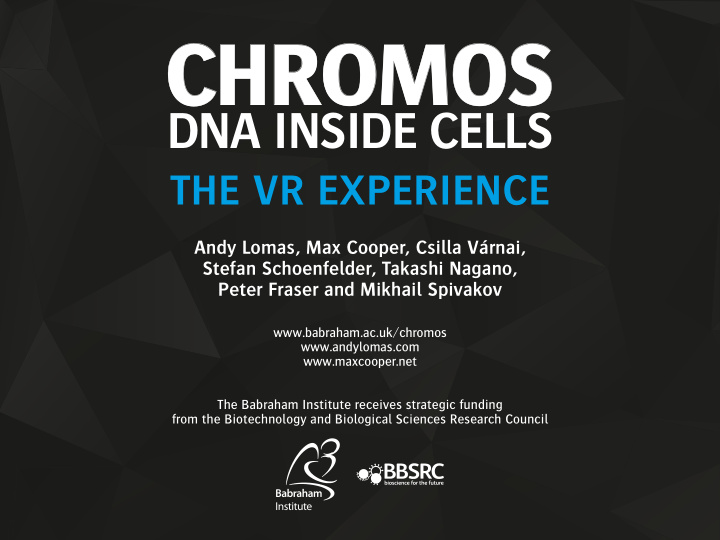



CHROMOS DNA INSIDE CELLS THE VR EXPERIENCE Andy Lomas, Max Cooper, Csilla Várnai, Stefan Schoenfelder, Takashi Nagano, Peter Fraser and Mikhail Spivakov www.babraham.ac.uk/chromos www.andylomas.com www.maxcooper.net The Babraham Institute receives strategic funding from the Biotechnology and Biological Sciences Research Council
...ACGACATTGCCTACATGGTCAAA... The human genome (all DNA in each cell’s nucleus) is made up of 3.2 billion letters which amounts to a book with 2 million pages.
Cell Nucleus ~10 μm Human Hair DNA ~2m 5kV X1,200 10μm The total length of the DNA in each human cell is nearly 2 metres. If you add up all the DNA in the body it would stretch to the Sun and back 67 times. So, our DNA needs to be tightly packaged in the cell’s nucleus.
1 2 3 4 5 6 7 8 9 10 11 12 13 14 15 16 17 18 19 20 21 22 X/Y Human DNA is packaged into 46 separate chromosomes. This is the view of the chromosomes that we’re used to seeing, but it’s only like this when cells are dividing.
Chromosomes Between cell divisions, chromosomes are much more ‘fuzzy’ and less structured. But, this is a low resolution view.
Biochemical methods developed by us and others, coupled with computational modelling result in a higher resolution picture of what DNA looks like “normally”.
Cross-Section Chromosome 1 Active Genes Inactive Genes DNA packaging is not just about stuffing the DNA into the nucleus – it’s also about regulating its activity. Active and inactive parts are segregated in the nucleus. Active genes are organised into hubs inside the nucleus with inactive ones pushed to the periphery.
Heart Muscle Cells Brain Cells Red Blood Cells Fat Cells Immune Cells There are more than 200 cell types in the human body and different cells need to read different parts of the DNA.
Heart Cell Gene A Gene B Gene C Brain Cells Gene A Gene B Gene C Red Blood Cells Gene B Gene A Gene C Molecular switches on the DNA known as ‘enhancers’ control which genes are turned and in different cells. Intriguingly, they are often far away on the DNA from the genes they control – in some cases, a million base pairs away.
Linear View Enhancer Gene Gene Enhancer If you looked at the linear strand of the DNA, you’d never guess that these regions were close together.
Gene Gene Enhancer Enhancer The genome folds in a way that brings these switches close to the genes they control.
Linear View Enhancer Gene Gene Enhancer Three Dimensional View Research by us and others has mapped 3D genome folding at high resolution, so that we now know which switches regulate which genes.
Linear View Broken Enhancer Gene Gene Enhancer Three Dimensional View This research is important as these switch regions contain mutations that cause disease, and without knowing the 3D structure it’s impossible to know what genes are affected, and what can be done to alleviate or treat it.
Broken Fixed In the future, it may be possible to rewire genes away from faulty switches and reconnect to those that are functional.
Some images in this presentation were sourced through Creative Commons. Please find credits below. Cell Nucleus, Slide 3 – Public Domain, commons.wikimedia.org/w/index.php?curid=3266416 Human Hair, Slide 3 - By CSIRO, CC BY 3.0, commons.wikimedia.org/w/index.php?curid=35489670 Karyotypes, Slide 4 - By National Human Genome Research Institute, www.genome.gov/Images/EdKit/bio1c_large.gif, Public Domain, https://commons. wikimedia.org/w/index.php?curid=2132905 Brain cell, Slide 8 - By GerryShaw - Standard tissue culture and immunofluorescence Previously published: Unpublished, CC BY-SA 3.0, commons.wikimedia.org/w/index.php?curid=26518273 Red Blood Cell, Slide 8 - By MDougM - Own work, Public Domain, commons.wikimedia.org/w/index.php?curid=5928688 Fat cell, Slide 8 - By Nephron - Own work, CC BY-SA 3.0, commons.wikimedia.org/w/index.php?curid=18883361 Heart Muscle Cell, Slide 8 - By Nephron - Own work, CC BY-SA 3.0, commons.wikimedia.org/w/index.php?curid=19466888 Immune Cell, Slide 8 - By Dr Graham Beards - Own work, CC BY-SA 3.0, commons.wikimedia.org/w/index.php?curid=20521950’
Research/Chromosome Structural Data Creation Mikhail Spivakov, Peter Fraser, Takashi Nagano, Stefan Schoenfelder and Csilla Várnai Animation/Visual System Programming Andy Lomas Music Max Cooper Special thanks to Tacita Croucher and The Babraham Institute, Cambridge. The Babraham Institute is strategically funded by the Biotechnology and Biosciences Research Council (BBSRC). www.babraham.ac.uk/chromos www.andylomas.com www.maxcooper.net
Recommend
More recommend